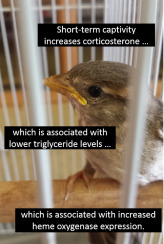当前位置:
X-MOL 学术
›
Comp. Biochem. Physiol. A Mol. Integr. Physiol.
›
论文详情
Our official English website, www.x-mol.net, welcomes your
feedback! (Note: you will need to create a separate account there.)
Effects of stress-induced increases of corticosterone on circulating triglyceride levels, biliverdin concentration, and heme oxygenase expression.
Comparative Biochemistry and Physiology A: Molecular & Integrative Physiology ( IF 2.1 ) Pub Date : 2019-11-05 , DOI: 10.1016/j.cbpa.2019.110608 Michael W Butler 1 , Ellen M Armour 1 , Jennifer A Minnick 1 , Marissa L Rossi 1 , Sydney F Schock 2 , Scott E Berger 2 , Justin K Hines 2
Comparative Biochemistry and Physiology A: Molecular & Integrative Physiology ( IF 2.1 ) Pub Date : 2019-11-05 , DOI: 10.1016/j.cbpa.2019.110608 Michael W Butler 1 , Ellen M Armour 1 , Jennifer A Minnick 1 , Marissa L Rossi 1 , Sydney F Schock 2 , Scott E Berger 2 , Justin K Hines 2
Affiliation

|
When exposed to stressors, animals physiologically respond by secreting glucocorticoid hormones. Most birds, reptiles, and amphibians secrete corticosterone (CORT), which allows them to maximize short-term survival, including by modulating lipid metabolism. However, the factors regulating lipid metabolism, particularly during acute (i.e., short-term) stressors, are not well-characterized. To investigate one putative mechanism, we examined how expression of the enzyme heme oxygenase (HO), which primarily converts heme into biliverdin, changes during an acute stressor. Because HO has links to decreased levels of triglycerides, we tested the hypothesis that an acute stressor increases HO expression, which would concomitantly decrease circulating lipid levels. We compared free-living house sparrow (Passer domesticus) nestlings exposed to a one-hour stressor to control individuals, and quantified HO expression and biliverdin concentration in spleen, liver, or kidney tissue, as well as circulating CORT, triglyceride, and glycerol levels. Nestlings exposed to a stressor had reduced circulating triglycerides consistent with an increased rate of gluconeogenesis during an acute stressor. Concentrations of triglycerides were also negatively correlated with HO expression in the liver, which is consistent with mammalian studies. However, contrary to our predictions, exposure to a stressor did not affect HO expression, or biliverdin concentration in liver, spleen, or kidney. Overall, our results support links between CORT, triglyceride levels, and HO expression, though the molecular pathways connecting these metrics still need to be elucidated.
中文翻译:

应激诱导的皮质酮增加对循环甘油三酸酯水平,biliverdin浓度和血红素加氧酶表达的影响。
当暴露于压力源时,动物会通过分泌糖皮质激素来产生生理反应。大多数鸟类,爬行动物和两栖动物都会分泌皮质酮(CORT),从而使它们能够通过调节脂质代谢来最大程度地提高短期生存率。但是,调节脂质代谢的因素,特别是在急性(即短期)应激源期间,尚不十分清楚。为了研究一种推定的机制,我们研究了急性应激源期间血红素加氧酶(HO)的表达如何发生变化,血红素加氧酶主要将血红素转化为biliverdin。因为HO与甘油三酯水平的降低有关,所以我们测试了一个假设,即急性应激源会增加HO的表达,这会相应地降低循环血脂水平。我们比较了暴露于一小时应激源以控制个体的自由麻雀(Passer domesticus)雏鸟的数量,并量化了其在脾脏,肝脏或肾脏组织中的HO表达和biliverdin浓度,以及循环CORT,甘油三酯和甘油水平。暴露在应激源下的雏鸟减少的循环甘油三酸酯与急性应激源期间糖原异生率的增加相一致。甘油三酸酯的浓度也与肝脏中HO的表达呈负相关,这与哺乳动物的研究一致。但是,与我们的预测相反,暴露于应激源下不会影响HO表达,肝脏,脾脏或肾脏中的biliverdin浓度。总体而言,我们的结果支持CORT,甘油三酸酯水平和HO表达之间的联系,
更新日期:2019-11-05
中文翻译:

应激诱导的皮质酮增加对循环甘油三酸酯水平,biliverdin浓度和血红素加氧酶表达的影响。
当暴露于压力源时,动物会通过分泌糖皮质激素来产生生理反应。大多数鸟类,爬行动物和两栖动物都会分泌皮质酮(CORT),从而使它们能够通过调节脂质代谢来最大程度地提高短期生存率。但是,调节脂质代谢的因素,特别是在急性(即短期)应激源期间,尚不十分清楚。为了研究一种推定的机制,我们研究了急性应激源期间血红素加氧酶(HO)的表达如何发生变化,血红素加氧酶主要将血红素转化为biliverdin。因为HO与甘油三酯水平的降低有关,所以我们测试了一个假设,即急性应激源会增加HO的表达,这会相应地降低循环血脂水平。我们比较了暴露于一小时应激源以控制个体的自由麻雀(Passer domesticus)雏鸟的数量,并量化了其在脾脏,肝脏或肾脏组织中的HO表达和biliverdin浓度,以及循环CORT,甘油三酯和甘油水平。暴露在应激源下的雏鸟减少的循环甘油三酸酯与急性应激源期间糖原异生率的增加相一致。甘油三酸酯的浓度也与肝脏中HO的表达呈负相关,这与哺乳动物的研究一致。但是,与我们的预测相反,暴露于应激源下不会影响HO表达,肝脏,脾脏或肾脏中的biliverdin浓度。总体而言,我们的结果支持CORT,甘油三酸酯水平和HO表达之间的联系,









































 京公网安备 11010802027423号
京公网安备 11010802027423号